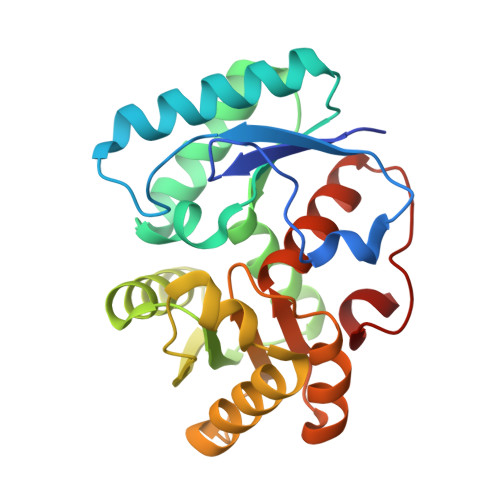Structural Basis for Inverting the Enantioselectivity of Arylmalonate Decarboxylase Revealed by the Structural Analysis of the Gly74Cys/Cys188Ser Mutant in the Liganded Form
Obata, R., Nakasako, M.(2010) Biochemistry 49: 1963-1969
- PubMed: 20136121
- DOI: https://doi.org/10.1021/bi9015605
- Primary Citation of Related Structures:
3DTV, 3IXL, 3IXM - PubMed Abstract:
Arylmalonate decarboxylase catalyzes the enantioselective decarboxylation of alpha-aryl-alpha-methylmalonate to produce optically pure alpha-arylpropionate. The enzyme is comprised of two alpha/beta domains and contains an active site situated between the two domains. The site is formed by Tyr48, Gly74-Thr75-Ser76, Tyr126, and Cys188-Gly189-Gly190 residues. Since it has been observed that the Gly74Cys/Cys188Ser mutation inverts the enantioselectivity of the enzyme, we determined the crystal structure of the Gly74Cys/Cys188Ser mutant in the liganded form at a resolution of 1.45 A to understand the structural basis for this inversion. The overall structure of the enzyme overlapped well with that of the benzylphosphonate-associated wild-type enzyme, and the mutations had little effect on the structure of the active site. A ligand molecule bound to the active site in an unusual semiplanar conformation resembling the planar enediolate reaction intermediate could be assigned as phenyl acetate. The inversion in enantioselectivity by the paired mutation is explained by the mirror symmetry between Cys74 in the mutant and Cys188 of the wild type with respect to the carbon atom in the ligand to be protonated. Comparison of the wild-type and Gly74Cys mutant crystal structures suggested that ligand binding induces a positional shift of the Cys188-Gly189-Gly190 region toward the Gly74-Thr75 pair which provides two oxyanion holes necessary to stabilize the negatively charged enediolate reaction intermediate. The ligand binding also simultaneously induces the formation of a hydrophobic cluster over the active site cleft. Thus, AMDase is proposed to have "open" and "closed" conformations of the active site that are regulated by ligand binding. These results may provide an effective strategy for the rational design to invert the enantioselectivity of enzymes.
Organizational Affiliation:
Department of Physics, Faculty of Science and Technology, Keio University, 3-14-1 Hiyoshi, Kohoku-ku, Yokohama, Kanagawa 223-8522, Japan.















